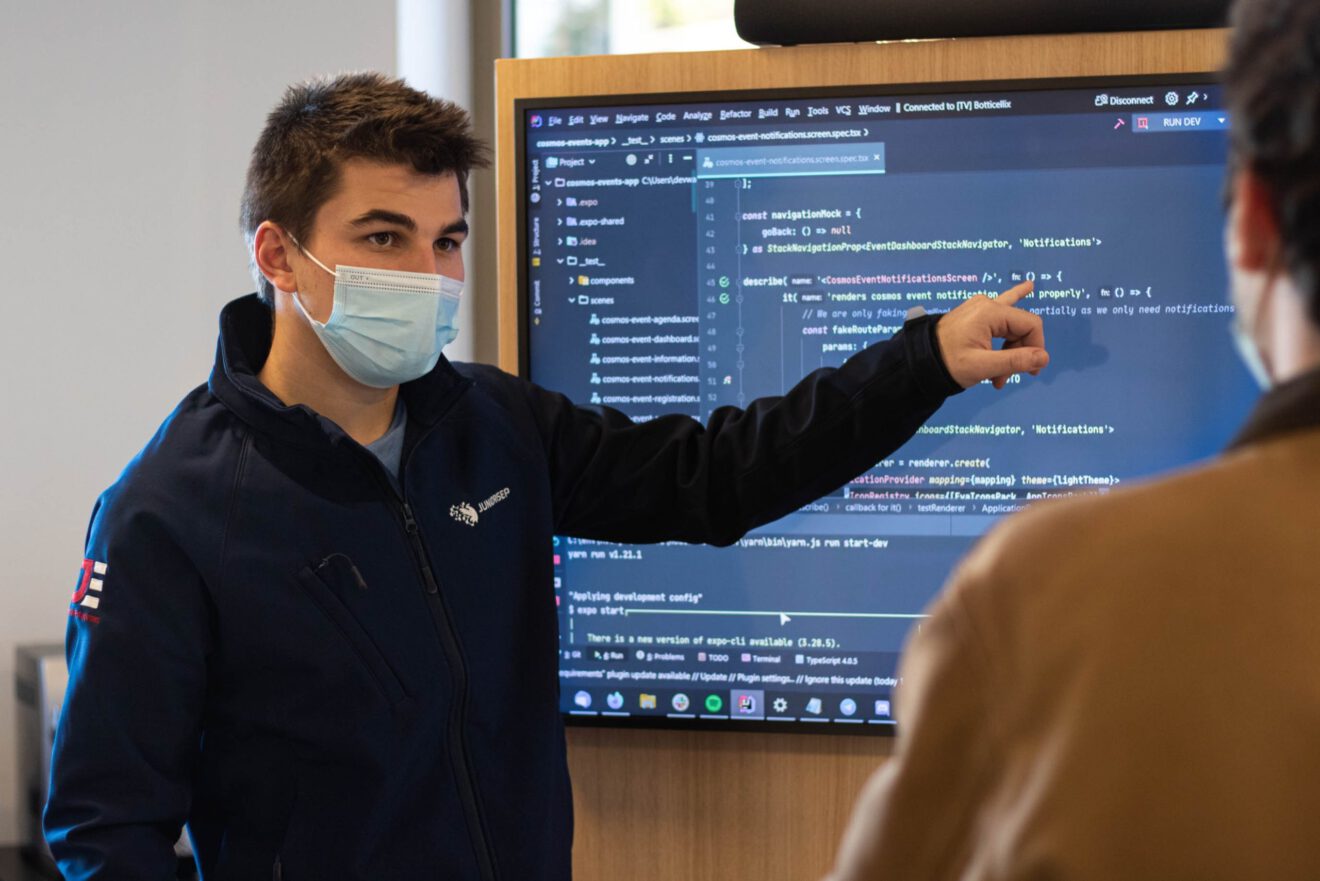Schools are facing a crossroads: Will classrooms shift to a more personalized approach to learning? Or will they maintain the status quo of whole-class, teacher-directed, single-paced instruction? These questions have prompted a lot of research at the Christensen Institute.

Fortunately, the pandemic helped lay the groundwork for moving toward more personalized practices. Many teachers discovered new technologies and strategies for remote and hybrid instruction that prove valuable for classroom-based instruction as well.
“The upside of being forced into remote learning is that it made me embrace a number of technologies that I wouldn’t otherwise have been motivated to learn,” one teacher shared in response to a Christensen Institute/Bay View Analytics survey.
Additionally, with the influx of federal pandemic-related education funds, many schools and districts made large investments in devices, Internet access, software and professional development for remote instruction that can now be used for more personalized learning models.
“Most teachers feel like zombies”
Even though the need for a personalized approach to learning is clear and much of the infrastructure is in place, this is a hard time to ask teachers to innovate. Over the last two school years, our series of nationally representative surveys of K-12 teachers and administrators has sought to learn how the staff were fairing during the pandemic. More than 70% of teachers who responded to our most recent survey reported facing a great deal of work-related stress. Additionally, a third of male teachers and half of female teachers said their workloads were not sustainable.
Teachers today face increased demands on their time, all while dealing with heightened challenges on their plates — ranging from catching students up after pandemic learning loss, supporting students with heightened social and emotional challenges, and filling in areas where their schools are short-staffed.
Consider how teachers described these challenges in their own words:
- “Less planning time and more meetings mean that the planning is lagging behind. And the need for constant coverage due to illness and teachers planning to leave the profession is over-taxing those of us who plan to continue, (which is) creating even greater burnout.”
- “Most teachers feel like zombies just going through the motions of the day.”
- “The workload is unreal. The pressure on teachers during this time is more than ever before.”
Under these circumstances, is it feasible for schools and districts to attempt a push to make classrooms more personalized? An affirmative answer to that question hinges on understanding how teachers’ circumstances affect their motivation to adopt new tools and practices.
The “Job” behind teachers’ jobs
Using a theory and methodology called Jobs To Be Done — developed by our institute’s founder and validated through extensive research in other sectors — we set out in 2018 to uncover the factors that motivate teachers to use new practices in their classrooms for a personalized approach to learning. Specifically, we interviewed teachers who had recently pivoted to blended or project-based teaching to identify the events and circumstances that prompted them to bring these new practices into their classrooms.
According to the theory, teachers change their practices when they have an unmet “Job” they need to fulfill. We call these Jobs because, just as people hire contractors to help them build houses or lawyers to help them build a case, teachers search for something they can “hire” to help them with a particular issue. Jobs theory cuts through the noise of what teachers say they want, or what school leaders expect them to do, in order to identify the events and circumstances that actually cause them to make the decisions they make.
Through our interviews about teachers’ quest for progress, we uncovered four Jobs that motivate teachers to change their instruction:
Job 1: Help me lead the way in improving my school. Teachers with this Job were eager to demonstrate their value as contributors to broader school improvement efforts. They looked for promising yet simple practices that would be straightforward to share with their colleagues.
Job 2: Help me engage and challenge more of my students in a way that’s manageable. Teachers with this Job were happy overall with the teaching and learning in their classrooms but wanted practical strategies for reaching a few students who were slipping through the cracks.
Job 3: Help me replace a broken instructional model so I can reach each student. Teachers with this Job taught in circumstances where few students were succeeding academically. They were eager for radical new approaches that would help them find a renewed sense of purpose as teachers.
Job 4: Help me to not fall behind on my school’s new initiative. For these teachers, their schools’ initiatives didn’t seem to offer viable ways to reach their goals and thereby created compliance-oriented motivation. They focused on doing what they had to do to not disappoint their school leaders, colleagues and students.
The surveys’ results lead to these recommendations
At first glance, these Jobs may seem intuitive or even obvious to anyone who works in schools. But the nuances of the Jobs reveal key parameters that any new instructional program must meet to gain traction among teachers — and ultimately influence classroom instructional modalities. School leaders can employ insights from these Jobs in two ways.
First, school leaders should design their programs to fulfill Jobs that are already relevant for their teachers.
You can’t force a teacher to have a particular Job. But when you appeal to a Job they already have, adoption happens organically.
For example, if a substantial portion of a school’s teaching staff finds motivation in fulfilling Job 2, school leaders should work with teachers to pinpoint the students that are particularly difficult to reach, and then select new instructional approaches designed to engage those students.
Importantly, however, to fulfill Job 2, each new personalized approach to learning needs to be straightforward complements to whatever teachers are already doing. If the new practices are not manageable additions to teachers’ current strategies, those new practices will be dead in the water. Teachers with Job 2 aren’t interested in so-called great ideas that double their workload or require them to throw out their favorite lesson activities.
Second, if a program doesn’t line up well with existing Jobs, leaders can prime teachers for new initiatives by shaping the circumstances that activate latent Jobs.
For example, many of the teachers we interviewed with Job 3 only came to that Job after their experiences gave them a strong sense that far too many of their students were slipping through the cracks. One high-school math teacher was routinely frustrated when his students just wanted to regurgitate steps without trying to understand mathematical concepts. Another teacher felt defeated by ongoing behavior issues from a large proportion of disengaged students.
Helping teachers reckon with such experiences can be a powerful catalyst for motivating them to set aside their long-standing approaches and seek something better, such as a personalized approach to learning. When school leaders highlight the shortcomings in a classroom in ways that help teachers realize for themselves that the status quo needs to change, those experiences can activate dormant Jobs for teachers and lead them to proactively seek new approaches to teaching.
Understanding teachers’ Jobs is the key to shifting from coercive to inspiring forms of management. When school leaders use Jobs to shape their school improvement programs, they create the circumstances for those programs to flourish organically across their schools.
A teacher’s progress is a student’s progress
At this juncture in K-12 education, some classrooms will make strides toward more personalized instruction, while others will retrench to the tried and true. To increase the likelihood that classrooms pursue the first path, administrators should start by understanding teachers’ Jobs To Be Done and then align the new tools and practices with those Jobs.
Thomas Arnett is a senior research fellow for the Clayton Christensen Institute, which conducted the “Reaching Toward Recovery: Fall 2021 Survey of Teachers and Administrators,” “A Revealing Reality: Spring 2022 Survey of Teachers and Administrators” and “The Teachers’ Quest for Progress: How School Leaders Can Motivate Instructional Innovation” studies. Arnett’s work focuses on using the Theory of Disruptive Innovation to study innovative instructional models and their potential to scale student-centered learning in K-12 education. He also studies demand for innovative resources and practices across the K-12 education system.
Opinions expressed by SmartBrief contributors are their own.
_________________________
Subscribe to SmartBrief’s FREE email ASCD newsletter to see the latest hot topics in education. It’s among SmartBrief’s more than 250 industry-focused newsletters.
